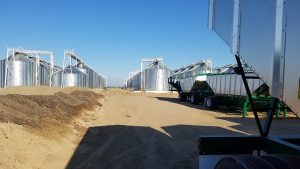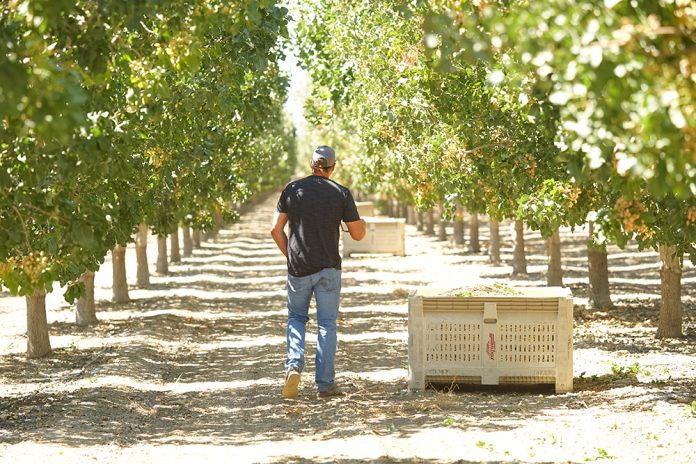Prices for California pistachios are expected to hold steady in the next few years despite record and near-record crops, according to a projection from David Magaña, a senior analyst with Rabobank.
This, combined with a pistachio tree’s adaptability to Central Valley environmental conditions and improved yields as new varieties begin to bear fruit, have put pistachios in an outstanding position, he said.
In an interview with West Coast Nut magazine, Magaña, who has compiled an annual report on California pistachios the last four years, characterized recent developments in the pistachio industry as “pretty remarkable.”
“This has been a success story, even in the presence of a lot of challenges,” he said, including drought in the Central Valley, logistical challenges for shipping and increasing input costs. “The industry has not only been growing fast, but also showing better profitability when compared to competing crops.”
At the heart of the industry’s success is a dramatic increase in production that is far outpacing other California tree nuts. Rabobank is estimating that bearing acreage of pistachios will increase from approximately 370,000 acres today to 470,000 acres by 2026.
“It is the fastest-growing tree nut industry in California,” he said. “By 2026, we are estimating that bearing acreage of walnuts will be two times that of 2000, and almonds three times that of 2000. However, pistachio bearing acreage will be almost seven times that of two decades ago.”
In addition, new varieties have reduced the yield variability between ‘on years’ and ‘off years,’ he said, providing a consistency of supply that is attractive to buyers and shippers.
“One aspect of having these more consistent supplies… is an ability for this industry to be shipping on time,” Magaña said. “For example, one of the biggest demand drivers in the international markets is the Chinese New Year. So, the industry has been making efforts to send shipments early in the season so that pistachios are already in destination markets ready for prime time.”
Marketing Message
Another key to its international successes has been a marketing platform based on nutritional research that shows pistachios are one of the only plant-based complete proteins available to consumers.
“Those marketing efforts by the industry have been quite relevant, particularly focusing on the [nutritional] quality of the U.S. pistachios,” Magaña said. “And also, food-safety continues to be a competitive advantage for U.S. product compared to international competitors.”
In his report, Magaña wrote that total U.S. pistachio exports are expected to keep pace with expanded U.S. supplies in the years ahead, due in part to freer market access to key Asian markets and sustained growth to Europe.
He further noted that continuing efforts to increase demand both at home and abroad “will become increasingly relevant as planted area continues to expand.”
“Given the planted acreage and age of trees and considering typical yield probability distributions, we expect overall record crops in 2022-23 and 2024-25, while we could see record highs for an ‘off-year’ crop in 2023-24 and 2025-26,” he wrote in the report.
Magaña noted that he has since downgraded the projected size of this year’s crop after issues with pollination and early water restrictions put a question mark on the production outlook for the 2022 crop season.
“It likely is not going to be larger than last year’s,” he said.
But he still expects a crop approaching the billion-pound mark, a mark the industry first attained in 2020 and topped again in 2021, which he said was a remarkable showing for what was supposed to be an off year.
His report noted the average price expected to growers between now and the 2025-26 period to be around $2.69 a pound.
“Overall, the average price outlook for U.S. pistachios is favorable,” he wrote, “while the relevant industry-wide challenges and opportunities lie ahead.”

Domestic Sales Up
In addition to a strong growth in international markets, Magaña wrote that domestic market growth for pistachios also has been successful in recent years.
“As for domestic trends,” he wrote, “per capita consumption has expanded at a compound annual growth rate of over 10% during the recent decade, surpassing the growth rate of most fruits and nuts.”
“The U.S. market continues to absorb higher volumes of pistachios,” Magaña said. “Now you can find pistachio presentations in pretty much any convenience story and in any supermarket. That has also been a marketing success for the industry in the domestic market.”
He added that the relative youth of the U.S. pistachio industry gives it plenty of room for growth, but that the industry needs to continue to capitalize on its nutrition-based marketing platform.
“Further innovation and strategic partnerships are needed to continue to capitalize on plant-based protein diets as well as the demand from health-conscious consumers for confectionary bars and gourmet products that can contain pistachio kernels. Research on and promotion of healthfulness will continue to be important demand drivers,” he wrote.
Several Challenges
Magaña identified several challenges in his report, including notably severe drought conditions, the effects of water and environmental regulations on pistachio production, increasing input costs and the effects of soil salinity on plant health.
“A silver lining here is that pistachios tend to adapt better to different soil types and have relatively higher tolerance to salinity than competing crops,” he wrote.
“Now that we have less availability of surface water, which is of higher quality, the growers need to be pumping more groundwater, bringing more minerals and more salinity to the soil, and some crops are more sensitive in terms of yield this salinity,” Magaña said in the follow-up interview. “A pistachio tree is a true desert tree, and so it is more resistant to salinity.”
Also, he said, it will be interesting to see if U.S. international market shares in pistachio sales continue as strong as in the recent past if Iran and Turkey come on with big crops in coming years. Both had relatively poor crops the last two years, which has helped boost U.S. market share in several foreign markets.
“We will truly see how strong the global demand for pistachios really is when the U.S. has an on year at the same time as Iran and Turkey,” he said.
Projecting out, Magaña said he expects the pistachio industry to continue to enjoy a healthy expansion that includes increases in exports and domestic sales as well as steady prices.
“In our price estimates, we are accounting for international demand, domestic demand and also the availability of the U.S. market,” he said. “And still, we are optimistic about the future for this industry.
“We will see this industry continue as the fastest-growing tree nut segment in California agriculture,” Magaña said.











